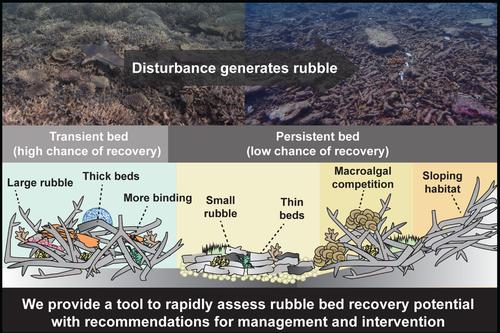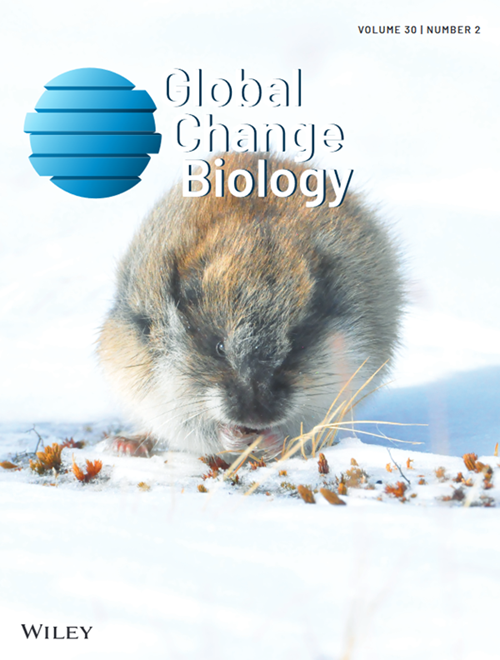Material Legacies on Coral Reefs: Rubble Length and Bed Thickness Are Key Drivers of Rubble Bed Recovery
IF 10.8
1区 环境科学与生态学
Q1 BIODIVERSITY CONSERVATION
引用次数: 0
Abstract
Disturbances on coral reefs—which are increasing in intensity and frequency—generate material legacies. These are commonly in the form of rubble beds, which depend on rubble stability and/or binding to facilitate coral recruitment and recovery. Yet, our understanding of rubble stability and binding dynamics across environmental gradients is limited. Characterising and categorising rubble material legacies in context of their likely recovery trajectory is imperative to the effective deployment of active intervention strategies used to restore degraded reefs, such as rubble stabilisation, coral outplanting and larval seeding techniques. We quantified rubble characteristics across environmental gradients on the Great Barrier Reef. The likelihood of rubble stability and binding increased with rubble length and rubble bed thickness, and rubble length was a good predictor of bed thickness and rubble branchiness. Thin rubble bed profiles (< ~10 cm depth), those with small, unbranched rubble pieces (< ~10 cm length), and beds at the base of sloped rubble screes, had lower stability and binding likelihoods. These kinds of beds are expected to persist with low recovery prospects, and could be good candidates for rubble stabilisation interventions. Thicker rubble beds with larger, branched rubble pieces tended to exhibit higher stability and binding likelihoods. However, these beds had nuanced effects on coral cover, and interventions may still be necessary where competition is high, for example from macroalgae. A rapid assessment of rubble length—while also considering shelf location, geomorphic zone, slope angle and underlying substrate—can indicate the potential direction of a rubble bed's recovery trajectory. Our findings have been summarised into a rapid rubble bed assessment tool available in the Supporting Information, that can be incorporated into current reef monitoring to optimize prioritisation of intervention strategies at disturbed sites.

珊瑚礁上的物质遗产:碎屑长度和礁床厚度是碎屑礁床恢复的关键因素
对珊瑚礁的扰动--其强度和频率都在增加--会产生物质遗产。这些物质通常以碎石床的形式存在,它们依赖碎石的稳定性和/或结合力来促进珊瑚的繁殖和恢复。然而,我们对不同环境梯度中碎石稳定性和结合力动态的了解还很有限。要有效地部署用于恢复退化珊瑚礁的积极干预策略,如碎石稳定、珊瑚移植和幼虫播种技术,就必须根据其可能的恢复轨迹对碎石材料的遗留物进行特征描述和分类。我们对大堡礁不同环境梯度的碎石特征进行了量化。碎石稳定性和粘结性随碎石长度和碎石床厚度的增加而增加,碎石长度可以很好地预测碎石床厚度和碎石分枝度。薄的碎石床剖面(深度约为 10 厘米)、碎石块较小且未分枝(长度约为 10 厘米)的碎石床以及位于倾斜碎石斜坡底部的碎石床的稳定性和结合可能性较低。预计这类岩床将持续存在,但恢复前景较低,可以作为碎石稳定干预措施的良好候选。厚度较厚、碎石块较大、分支较多的碎石岩床往往表现出较高的稳定性和结合可能性。然而,这些石床对珊瑚覆盖率的影响是微妙的,在竞争激烈的地方,例如大型藻类的竞争,可能仍有必要采取干预措施。对碎石长度进行快速评估,同时考虑陆架位置、地貌区、斜坡角度和底层基质,可以指明碎石海床恢复轨迹的潜在方向。我们的研究结果已总结成一个碎石床快速评估工具(见 "辅助资料"),该工具可用于当前的珊瑚礁监测,以优化受干扰地点干预策略的优先次序。
本文章由计算机程序翻译,如有差异,请以英文原文为准。
求助全文
约1分钟内获得全文
求助全文
来源期刊

Global Change Biology
环境科学-环境科学
CiteScore
21.50
自引率
5.20%
发文量
497
审稿时长
3.3 months
期刊介绍:
Global Change Biology is an environmental change journal committed to shaping the future and addressing the world's most pressing challenges, including sustainability, climate change, environmental protection, food and water safety, and global health.
Dedicated to fostering a profound understanding of the impacts of global change on biological systems and offering innovative solutions, the journal publishes a diverse range of content, including primary research articles, technical advances, research reviews, reports, opinions, perspectives, commentaries, and letters. Starting with the 2024 volume, Global Change Biology will transition to an online-only format, enhancing accessibility and contributing to the evolution of scholarly communication.
 求助内容:
求助内容: 应助结果提醒方式:
应助结果提醒方式:


